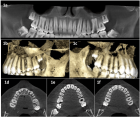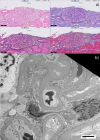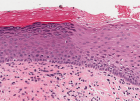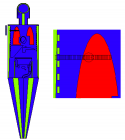Table of Contents
SGLT2 Inhibitors and nephroprotection in diabetic kidney disease: From mechanisms of action to the latest evidence in the literature
Published on: 21st August, 2020
OCLC Number/Unique Identifier: 8651234199
Type 2 Diabetes Mellitus constitutes a major problem in public health worldwide. The disease poses a high risk of severe microvascular and macrovascular complications. Diabetic kidney disease is the most common cause of end-stage chronic kidney disease and contributes to the increasing morbidity and mortality associated to diabetes. Sodium-glucose contransporter-2 inhibitors (SGLT2 inhibitors) are the latest oral diabetic medications, which exhibit a great nephroprotective potential, not only by improving glycemic control, but also by glucose-independent mechanisms, such as decreasing blood pressure and other direct renal effects. We conduct a literature review based on the most recent scientific evidence with the goal to elucidate the postulated mechanisms of action of SGLT2 inhibitors in diabetic kidney disease, which are the base of the beneficial clinical effects that are seen in the condition.
Correlation between interdialytic weight gain, left ventricular hypertrophy and FGF- 23 in prevalent hemodialysis patients
Published on: 28th July, 2020
OCLC Number/Unique Identifier: 8648999984
Background:Patients with end-stage renal disease are suspected to have significant volume shifts and thereby cardiovascular strain as a result to interdialytic weight gain, chronic fluid overload and fluid removal during dialysis. In long-term hemodialysis patients, higher IDWG (interdialytic weight gain) could be associated with poor survival. Patients with the lowest interdialytic weight gain have the greatest survival. Certain laboratory and imaging modalities could help to assess and monitor the appropriate fluid balance for hemodialysis patients.
FGF -23 might be associated with cardiovascular morbidity in ESRD patients.
Objective: To evaluate correlation between hypervolemia and left ventricular hypertrophy and FGF-23 in hemodialysis patients.
Patients and Methods: This cross sectional study was conducted on 60 prevalent hemodialysis patients. Patients were divided into two groups according to interdialytic weight gain (IDWG): Group I (low IDWG): Patients with absolute weight gain < 3 kg. Group II (high IDWG): patients with weight gain ≥ 3 kg. FGF 23, routine laboratory tests and echocardiography were done for both groups.
Results: high IDWG group has higher systolic blood pressure and LVMI than low IDWG group. In all patients group, FGF-23 had a positive correlation with (weight gain, Na, PO4, PTH, systolic, diastolic blood pressure, LV wall septal and posterior wall thickness and left ventricular mass index) and had a negative correlation with Hb level.
Conclusion: FGF-23 could be a marker of volume overload and LVH in ESRD patients, which affect morbidity and mortality in these patients.
FGF- 23 might be a marker of anemia in ESRD as it has a negative correlation with HB.
Biomarkers in acute kidney injury
Published on: 20th July, 2020
OCLC Number/Unique Identifier: 8635214937
Acute kidney injury is a common condition associated with high morbidity and short-term mortality. Its pathophysiology varies according to the numerous conditions associated with its genesis. Biomarkers allow detecting changes at the level of kidney function; therefore, they play an important role in the prevention, early diagnosis, therapeutic response and prognosis of acute kidney injury. The search for biomarkers for acute kidney injury began over 15 years ago; initially, only serum creatinine was available for diagnosis. However, throughout history, great advances have been made in research, which have allowed the finding of new biomarkers in order to improve the health and quality of life of patients. A narrative review of the literature is carried out on the basis of available scientific evidence to clarify the role and importance of biomarkers in the context of acute renal injury.
Specific meningoencephalitis in patients with transplanted kidney
Published on: 17th June, 2020
OCLC Number/Unique Identifier: 8628628844
We described a case of specific (tuberculous) encephalitis in a patient after kidney transplantation. Immunosuppressive therapy, continuously required in post-tranplant period, may cause various complications, such as infections. Specific meningoencephalitis is an infection that is rarely diagnosed and more common in immunocompromised patients.
Case report: A 30-year-old man had kidney transplantation (kidney donor was his father). He previously was two years on chronic hemodialysis treatment because of end-stagerenal disease based on diabetic nephropathy. He has diabetes type 1. The early post-transplant period duly passed with satisfactory clinical and laboratory parameters of renal function. Two months after transplantation, he presented with febrile condition, signs of septicemia and dehydration with significant neurological deficit and expressed meningeal signs. In cerebrospinal fluid we found lymphocytosis, elevated proteins and positive micobacterium tuberculosis antibodies (Hexagon method) and we suspected to specific etiology of meningitis. Performed computed tomography (CT) scan of the brain with contrast confirmed the expected finding.
Due to the poor prognosis of infections of the central nervous system (CNS) in immunocompromised patients, only prompt diagnosis can improve survival in this group of patients. The therapeutic protocol after kidney transplantation include the prophylactic use of antituberculous drug (Isoniazid 300 mg) during the 9 months.
How does urine pH effect the tooth decay?
Published on: 5th June, 2020
OCLC Number/Unique Identifier: 8614540735
The basic aim of the present study was to relate tooth decay with the pH of the urine. pH is very important aspect which affects and depends upon the urine specificity. The glomerulus is a necessary part in the structure of kidney. The glomerulus is involved in the filtration of blood, which is involved in acidification with the help of kidneys. A cavity or hole is formed within the tooth and it can leads towards tooth decay. Cavity in its structure is so small when it is at its starting point but with the passage of time cavity becomes large in between of the teeth and it can be a main reason to the complex diseases. A total of 100 students get participated in this study from Bahauddin Zakariya University Multan, Pakistan. In this subjects went into the lab with their urine samples taking in the urine collection bag. In this a strip is used to find the values pH. Strip is placed in the urine collection bag for a minute. Then we noted the different values of different subjects. We designed a research project based upon the results that depend upon either there was any relation among tooth decay and pH. The aim of the project was either there is any relation among the tooth decay and urine pH. It was concluded that there was no any kind of relation among urine pH and tooth decay.

HSPI: We're glad you're here. Please click "create a new Query" if you are a new visitor to our website and need further information from us.
If you are already a member of our network and need to keep track of any developments regarding a question you have already submitted, click "take me to my Query."


























































































































































